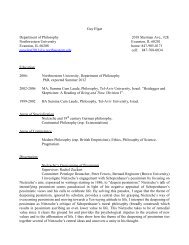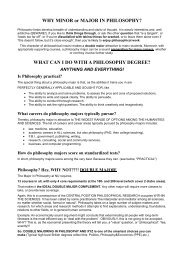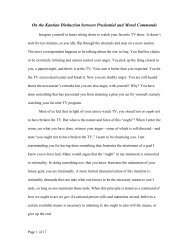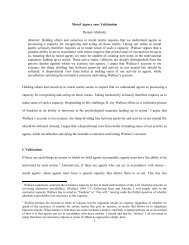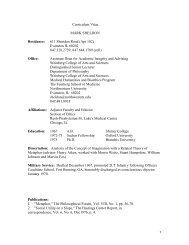Business Ethics John Laing Instructor j-laing@northwestern.edu ...
Business Ethics John Laing Instructor j-laing@northwestern.edu ...
Business Ethics John Laing Instructor j-laing@northwestern.edu ...
Create successful ePaper yourself
Turn your PDF publications into a flip-book with our unique Google optimized e-Paper software.
Deepen their ability to listen respectfully, rationally, and critically to the (sometimes<br />
opposing) points of view of others<br />
Develop the capacity to assess public policy debates in a more informed and reasoned<br />
fashion<br />
Teaching method: Lecture and discussion<br />
Evaluation method: Oral presentation on a topic of the student’s choosing (35%), final<br />
essay exam (35%), and contribution to discussion (30%).<br />
Grading: On the first day of class, I will explain in detail my approach to grading the<br />
different elements of this course. I will distribute rubrics summarizing my approach as<br />
well. Those rubrics will be posted on Blackboard.<br />
Readings and Assignments: Selections from Ethical Issues in <strong>Business</strong>: A<br />
Philosophical Approach, ed. Thomas Donaldson and Patricia H. Warhane (8 th Edition)<br />
will provide a primary basis of reading assignments for the course (ISBN-10: 0-13-<br />
184619-1 and ISBN-13: 978-0-13-184619-7) Additional reading assignments will be<br />
posted on Blackboard. Students also will be expected to watch two movies: “The<br />
Smartest Guys in the Room” and “The Insider.” Links to both movies will be provided<br />
on Blackboard.<br />
Student Presentations:<br />
On the first day of class, we will develop together a sch<strong>edu</strong>le for student presentations<br />
during the remainder of the term. I will explain what I expect regarding presentations on<br />
the topics listed below. Students will indicate whether they have a preference as to a<br />
topic on which to present. I will try to assign presentations in a way that respects those<br />
preferences to the extent possible.<br />
The purpose, role and responsibilities of the corporation<br />
The libertarian view<br />
The stake holder theory<br />
When corporations do right (one presentation)<br />
Example: <strong>John</strong>son & <strong>John</strong>son and Tylenol<br />
Example: S.C. <strong>John</strong>son and CFCs<br />
When corporations do wrong<br />
Example: Enron<br />
Example: Goldman Sachs<br />
The problem of externalities



